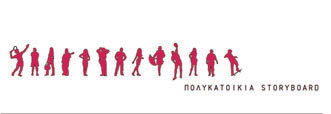

This is a building in the city centre of Volos, to the contribution of roads Dimitriados and Solonos. The users chosen, as well as the allocation of uses in this building, is non-conventional: the building was designed to house the lives four young women.
In this work it is attempted to revisit the issue of dwelling, through the renegotiation of occupancy and time of their inhabitants. The final result not only sheltering/serves the 4 users, but also all the people in their lives (friends, comrades, family), and all of their needs as well.
It is an attempt to design for a modern social organization, finally proposing a model of enlarged occupancy: users of building is not strictly 4 people, but their number varies. Users are potentially dozens, passed in building using premises and shredding the time within it.
The program underpins this situation: workplaces, rooms, spaces entertainment gymnastic etc. are an open invitation to a large number of persons at any time. In addition, inhabiting and work is two situations which disperse and mix in the building, in an attempt to renegotiate both occupancy and diffusion of space and time of the users.
The form resulting after various experiments. Though choreographies of the gap and of the full, volumes were born, volumes that are porous, self-sufficient in principle, unaffected by their environment in the beginning, later the urban fabric sculptures them, in a way that at the end urban fabric and building are tethered with common ideas and concepts: the gap and the full as two in dissociable information of space, the porous, which refers both in space and in time.
The idea of storyboard is involved in architectural design by early: the building is designed from the outset for Maro, Effie, Marian and Alexandra, experiments that form space were based on moments of the lives of these four women. The final result is the imprint of these highlights and constitutes a complicated form/shell open to much more people.
Supervisor: Paniyiris Costis
Reference Number: 229


The geographical setting of the study area is located in the region Karagats of the city of Volos and is delimited by the torrent Anavros – the road of G. Dimou - the road Nikotsara and the high importance Regional road. The area in question could be characterized as nodal point of the city considering that Anavros connects the mountainous area of Pilion with the city and the G. Dimou is a road of supralocal importance, since it delimits in the north the wider centre of Volos city and connects the two torrents Anavros - Krausidona, i.e. the western with the eastern edge of the city centre.
Firstly, we observed that the study area is characterized as an area of solely residence use. With the exception of the G. Dimou road which is a potential local centre because of its commercial - public use. Also, the central operations of the city of Volos are concentrated on the South and the unequal distribution of uses of the land, overloads the coastal area and its parallel streets with multiple operations.
The proposal aims in the transformation of the study area in an active urban landscape constituted by residences, places of public architecture, places of green and recreation seeking the discharge of the existing city centre with the creation of a new one. The proposal includes the development of residences -office buildings – primary school - shops – parking areas and leisure areas like cafeterias, restaurants, cinemas, sport facilities - courts and sport centre. It should be mentioned that the proposed building blocks apart from residences, they include commercial shops and attribute big part for public use. Among others, a basic objective is the restoration of Anavros and the projection of its natural character. The creation of a linear square – park is suggested, parallel of the torrent, which in combination with the proposed recreational uses, will be a pleasant esplanade for residents and visitors.
The character and the shape of every planning action, is a result of the analysis and utilization of the study area’s characteristics. The aim was the creation of a pole of attraction with local and supralocal scope via a network of buildings – points of interest, placed within the limits of the reformation area. Throughout the development course of the synthetic idea, there was a need of producing an enhanced model of city centre that renounces the “suburban style and ethics”.
Supervisor: Triantafillidis Giorgos
Reference Number: 228
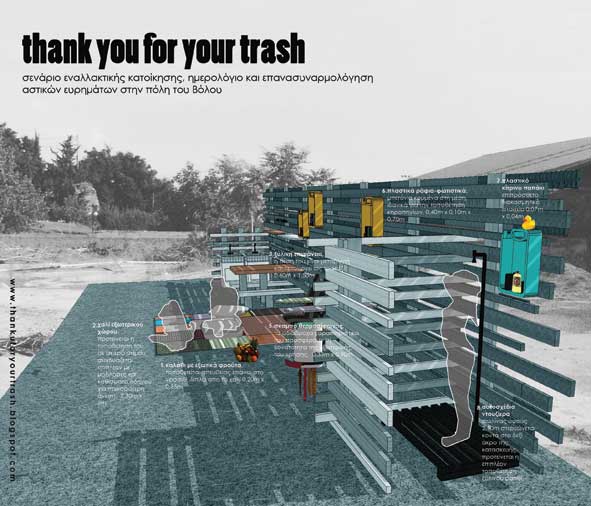

The subject of this final project concerns the research, the documentation, the reenactment and finally the re-contextualization of urban waste, composing an alternative inhabitation scenario.
This scenario is about a fictional resident of the city of Volos, who collects and files in a developing habitable archive of garbage, everything he finds abandoned in the streets and thinks that can be reused and reclaimed, from plastic bottles to mattresses and sofas.
He alters these objects by changing their original shape or even their properties, for personal use, initially, and finally he exhibits and sells his work.
In an attempt to imitate this resident we present our version of how someone could inhabit a space with self-made constructions based on our diary research in the city.
This project has an experimental and inquiring character and cannot be evaluated with the conventional criteria of architectural design. Our intention is not to examine the architectural composition and the “comfort” that can be provided by an object but the inhabitation alternatives that can contribute to the limitation of the unreasonable expansion of urban waste and consequently the improvement of everyday urban life.
Supervisor: Tzirtzilakis Yorgos
Reference Number: 244
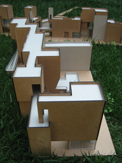

The Thessaloniki Contemporary Art Biennale is held in various places- mostly of monumental or exhibition nature- dispersed within the historic center of the city. The central idea of this proposal is based on two main principles, which are in a state of constant interaction, the spatial transfer and the identity of the facility. The spatial transfer combines a desire to step away of the city center with the simultaneous manifestation of introversion emerging on the one hand from the accumulation of multiple activities in a single place and on the other hand from the main way of communication of the entire operation via a navigable route. As for the matter of identity, this is indicated by the transfer of the simultaneous program of the Biennale to the new setting in the form of renting certain places of the building establishment to the each time participating galleries. The organizers of the Biennale will exploit the remaining spaces by hosting permanent or alternating exhibitions so that the facility remains a visiting site during the whole time until the beginning of the next exhibition.
The intervention is developed along four axes which come about on the one hand from an attempt of reading (comprehending) the lines of the scenery and on the other hand from the four directions which correspond, in approximation, to the four points of the horizon. The intersection point is of crucial importance as it distributes the divided movement to the axis. Moreover, the designed routes along the axes transfer us from function to function and as a result each time we return to the point of reference we have toured to all the functions of the certain axis.
The choice of the material isn’t based on chance but on the respect of the natural scenery. The construction doesn’t reveal its metal inner structure as with the continuous wooden covering it gives the impression of one wooden jumble of mass. In certain spots only, there are glass surfaces and some walls made of reinforced concrete, which appear in the form of towers and correspond to the elevators.
Supervisor: Antonas Aristide
Reference Number: 237
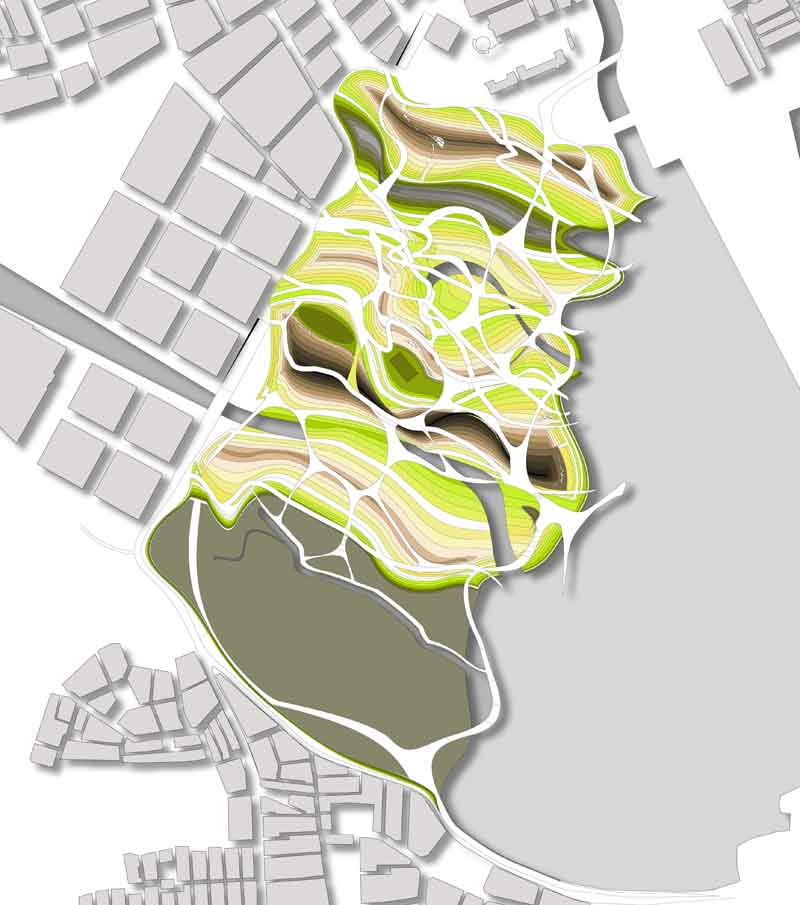

Nothing happens in living Nature that does not bear some relation to the whole.
Johamm Wolfgang von Goethe, 1792
The project “In between: Flows and events” apposes the issue of cost line’s continuity into the city of Volos. Based on a “swarm intelligence”1 and the reknown Goethe’s quote, the research process enriches the synthetic process, by collecting and combining data from a multidisciplinary environment, such as biology, anatomy, maths, agronomics and also by getting information from the local tradition and culture of Thessalia. In that context, our proposal evolves, based on the combination and by creating bonds between ostensibly incohesive things. The concept is blooming continuously, starting from a simple observation of the map of Volos city. The map, projects the intense condensation of the urban complex near the city centre, versus the lack of connection with the adjacent coastal areas. Moreover, when we focus into the area between the commercial port and the nature reserve area-biotope, in the West side of the coastal line, it can be observed the sparse connection with the main urban mesh on the north side and with the Peukakia area and the ancient ruins on the other one. Therefore, we get beneficial data from the perfect regulating centre of the most complicated network of communication of the whole world, the brain, in order to begin our proposal. Simultaneously, the existence of a nature reserve area-biotope into the site and the different representations of the city, as well as the concept of thinking the site as a hole into the urban texture, are valuable factors and events for the final proposal. In addition, the local culture and tradition, the old use of the area and the local nature, are factors, which enrich and modify the result. In that context the project deals with the creation of a landscape proposal, like a garden in which the neighbouring areas, such as the University from north, the area of Neapoli from the west side as well as the tourists (who arrive near the commercial port), can relax and take advantage of this site. Finally, the project, holds a landscape side, in order to strengthen the main concept which deals with the expansion of the nature reserve area-biotope like a landscape attack onto the built environment.
1 Reference in our research topic “ Swarm Intelligence” , February 2009
Supervisor: Kotionis Zissis
Reference Number: 221




For this project it was used an existing land in order to build an urban residence complex.
In order to achieve this study I used all terms of construction.
It was also examined how they affect the conditions of the planning area as open-space issues and typologies.
Finally, I studied in detail, construction and decorative items of the project.
Supervisor: Kotionis Zissis
Reference Number: 243
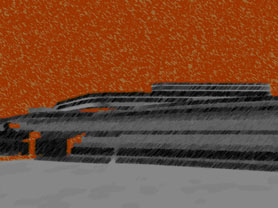

Conventional Tourism is connected with the attendance of meetings and exhibitions and represents an important market in then international level.
A group of buildings with a high quality hotel will attract Tourism. There are two halls: a conventional one (940 seats) and a multiused (288 seats) for the needs of the conventions and for the organization of many different manifestations. In addition, the spa, the swimming pools of the hotel, the restaurants, the cafeterias, the aquarium in the bar, the internet- café, the coverer area for parking, the shopping centre, the gym complete the perfect foundation of this group of buildings.
The principles of the design were: 1) the respect to the environment, 2) harmonious placement of the structure, 3) the healing of the wound which was cost by the operation of the quarry in the past. Clear shapes and plain forms follow the way the ground is, giving the impression of a light footstep.
The endless horizontality, the seriousness the contrast of black and white, the forms which flow as well as the sensation of the swinging in the air which are basically brought about by the boomerang, complete the synthetic process.
Key words: Conventional Tourism, Conventional group, plain forms, horizontality, boomerang.
Supervisor: Triantafillidis Giorgos
Reference Number: 219
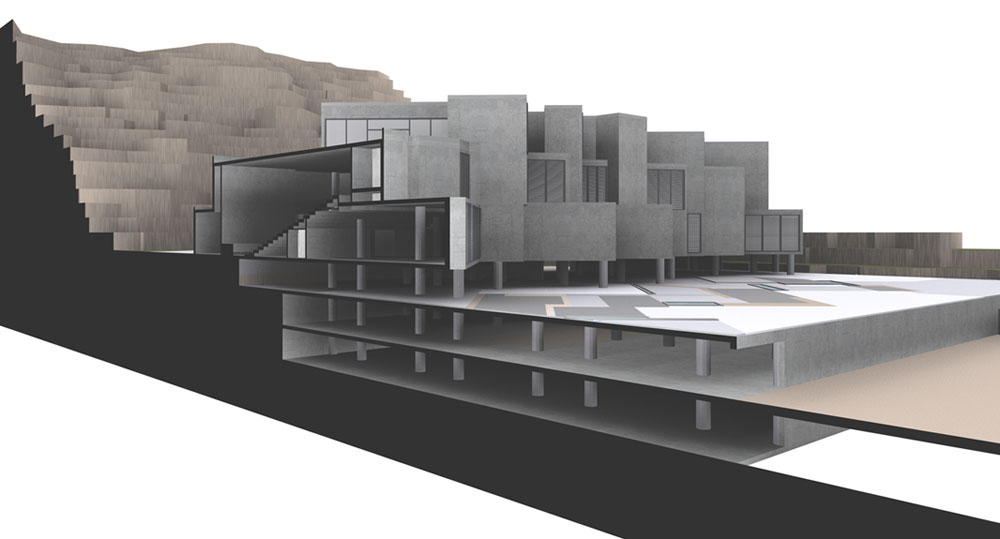

Volos is a city of 125000 inhabitants and home to approximately 12 faculties of the university of Thessalia, thus hosting thousands of students belonging to different scientific fields. In spite of that, however, there is no congressional centre for the realization of scientific congresses, lectures and presentations. These manifestations are hosted in hotel rooms, in the university amphitheatres which are of very small capacity, or in the Spirer building. The Municipal Theatre, which has a hall suitable for occasions like these, is often used by the Art Organisation of the Municipality of Volos for the realization of concerts, theatrical plays and other cultural performances.
For all the above reasons, the creation of a large, modern conference centre in the city of Volos is considered necessary so that it can host scientific congresses ,presentations and exhibitions, thus covering the needs not only of the city, but also of the broader area.
The building site under consideration is located at the foot of the hill of
Goritsa ,on the boundaries of the city. It stands on the central road artery between Volos and Argalasti (an extension of Polymeri street) which is one of the entrances to the city and which connects Volos to the area of Agria and the villages of Pilio.
It belongs to the coastal sea front of the city and has a view of the sea. Up until a few years ago there was a quarry in the area, which explains the looks of the location as it is today.
The design of the building was based morphologically on the picture of the quarry, and an effort was made to achieve interaction between the construction and the landscape, through reference made to the previous use of the specific location.
Below the main building there is a parking area with a basement and a ground floor, which functions as a pedestal creating a elevated square on its ceiling. Between them there is an indention on which the mechanical floor has been placed in order to separate the two bulks. This floor is interrupted at some point, thus allowing the communication of the square with a country area which is formed between the building and the hill.
The entrance of the vehicles is made either through the basement or through the part of the ground floor of the parking area which communicate with each other with a ramp, while the entrance for the pedestrians is made through a staircase from the first floor. Visitors head towards the foyer of the amphitheatre and then encounter the indoor stairways and the conference halls which have been designed as cores floating in space. In some cases these cores adjoin the outer shell so that the necessary natural light can be achieved. Spaces are created among them where permanent or periodical exhibitions can be hosted. Administration offices, a room with electronic computers and the restaurant have been placed on the last floor, taking advantage of the fact that they look over sea and the city.
The visible concrete was chosen as the basic material for the whole construction, in this way trying to achieve the feeling of unsteadiness and the variability that characterize a quarry. This brutalistic aesthetics is intensified even more through the use of grey metal door and window frames and blinds on the front of the construction.
On the floor of the square , apart from concrete which is coloured white in some parts, gravel as well as stone from the specific area co-exist. Finally, the splintering of the surface becomes more vivid with the presence of water.
Supervisor: Manolidis Kostas
Reference Number: 240

